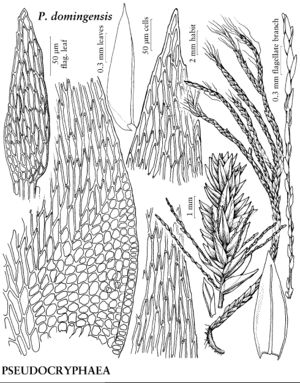Pseudocryphaea
in H. G. A. Engler et al., Nat. Pflanzenfam. ed. 2, 11: 98, fig. 502. 1925.
| Taxon | Illustrator ⠉ | |
|---|---|---|
 | Pseudocryphaea domingensis | Patricia M. Eckel |
Plants large, usually in thin, sometimes extensive, epiphytic colonies. Secondary stems irregularly branched or often regularly pinnate, often curved when dry, branches turned to one side; axillary hair basal-cells 1 (or 2), short, brown, intercalary cells 4–8, oblate, brown, distal cell 1, elongate, hyaline. Secondary stem and branch leaves similar, appressed and ± julaceous when dry, spreading when moist; base short-decurrent; margins mostly plane, sometimes revolute, entire proximally, subentire to serrulate distally; alar cells many, subquadrate to oblate, collenchymatous, region not reaching costa; laminal cells minutely but distinctly prorulose at both ends on both surfaces, smooth and porose toward yellowed insertion. Specialized asexual reproduction by flagellate branches often produced in distal leaf-axils, slender, usually unbranched, leaves small, ecostate. Gametangia and sporophytes unknown.
Distribution
Fla., West Indies, Central America, South America
Discussion
Species 1.
Pseudocryphaea is easily recognized by the julaceous habit with numerous, very slender flagellate branches. The leaves are 1-costate with relatively long cells that are minutely prorulose at both ends. Although the prorulae are small (H. A. Crum and L. E. Anderson 1981 cited the cells as smooth), they are easily seen at 400× since they are relatively elongate, although slender. The alar cells are extensively developed and subquadrate to oblate.
Selected References
None.